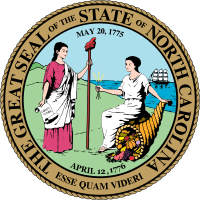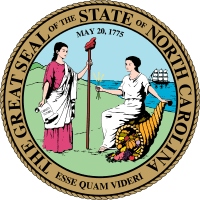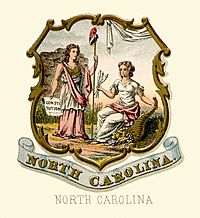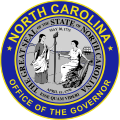Seal of North Carolina facts for kids
Quick facts for kids Great Seal of the State of North Carolina |
|
|---|---|
 |
|
| Versions | |

Seal of 1971-1984
|
|

Historical coat of arms (illustrated, 1876)
|
|
| Armiger | State of North Carolina |
| Adopted | 1971, officially (most recent change in 1984) |
| Motto | Esse quam videri |
The Great Seal of the State of North Carolina is a special symbol for the state. It's like an official stamp used on important documents. This seal shows important ideas and history about North Carolina.
Contents
History of the North Carolina Seal
The idea for the Great Seal first came from the North Carolina Constitution in 1776. The first version was made in 1778. The seal you see today mostly got its look in 1835.
In the 1800s, the North Carolina General Assembly passed a law. This law described exactly what the seal should look like.
What the Seal Looks Like
The seal is about two and one-quarter inches wide. Its design shows two main figures:
- Liberty: She is standing. She holds a pole with a cap on it in her left hand. This "pole with a cap" is called a liberty pole. It represents freedom. In her right hand, she has a scroll that says "Constitution."
- Plenty: She is sitting down. Her right arm reaches out towards Liberty. She holds three heads of grain in her right hand. In her left hand, she holds the small end of a horn. This horn is called a cornucopia or "horn of plenty." Its contents are spilling out at her feet. This figure represents wealth and a good harvest.
Background Details on the Seal
The background of the seal shows mountains running from the left to the middle. On the right side, there is a three-masted ship on the ocean.
Two important dates are also on the seal:
- May 20, 1775: This date is at the top of the seal. It refers to the Mecklenburg Declaration of Independence. This was an early statement of independence during the American Revolution.
- April 12, 1776: This date was added later. It refers to the Halifax Resolves. This was the first official action by an American colony calling for independence from Great Britain.
The words "Esse quam videri" are at the bottom of the seal. This is the state motto. It means "To Be Rather Than To Seem." These two dates and the motto are also on the flag of North Carolina.
Modern Changes to the Seal
In 1971, the seal was officially made the same everywhere. This happened because the state's chief deputy attorney general found that different versions were being used.
In 1983, a state senator named Julian R. Allsbrook suggested adding the date April 12, 1776, to the seal. The state legislature approved this change.
Other Government Seals of North Carolina
Many parts of the North Carolina government have their own seals. These seals often include elements from the Great Seal.
-
Seal of the Governor of North Carolina
Images for kids
-
North Carolina seal on plaque of monument to Major Joseph Winston, Guilford Courthouse National Military Park, Greensboro, North Carolina
See also
 In Spanish: Gran sello del estado de Carolina del Norte para niños
In Spanish: Gran sello del estado de Carolina del Norte para niños





